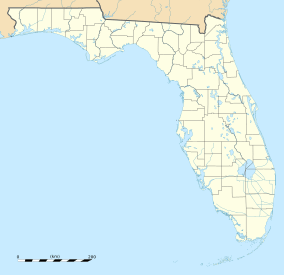San Antón de Carlos facts for kids
Quick facts for kids San Antón de Carlos ofMound Key Site |
|
|---|---|
|
IUCN Category IV (Habitat/Species Management Area)
|
|

San Antón de Carlos of
Mound Key Site Location in Florida
|
|
| Location | Lee County, Florida, USA |
| Nearest city | Fort Myers Beach, Florida |
| Established | August 12, 1970 |
| Governing body | Florida Department of Environmental Protection |
San Antonio de Carlos was an important Spanish settlement built in 1567. It was the very first mission started by the Jesuit priests in the Americas. This historic place is found today within Mound Key Archaeological State Park in Florida. It was once the main home for the Calusa people, who lived there for over 2,000 years.
Contents
Who Were the Calusa People?
In the 1500s, Spanish explorers began to visit Florida and the Caribbean. Juan Ponce de León arrived in 1513. He was the first European to meet the Calusa people. He was hurt by a Calusa warrior and later died from his injury. This showed how the Calusa resisted the Spanish.
Life with King Carlos
In the mid-1500s, a powerful leader named King Caalus, also known as Carlos, ruled over 20,000 Calusa people in southern Florida. He lived in a huge house on Mound Key. This island was special because it was made by the Calusa from discarded clam and oyster shells.
The Calusa people lived in many villages. They mostly ate shellfish, turtles, and fish. They also hunted birds and deer, and gathered other foods to complete their diet.
The Spanish Arrive
In 1566, Pedro Menéndez de Avilés became Spain's first Governor of Florida. He came with 200 soldiers, some of whom were musicians. They played fifes, trumpets, and drums. The Spanish built a fort, which also included a Jesuit mission.
Many Calusa people became sick from diseases brought by the Spanish. The Calusa had never been exposed to these illnesses before. Because the Calusa strongly resisted the Spanish, the Spanish left the site by 1569.
What Happened Next?
In 1697, another group of priests, called Franciscan friars, tried to convert the Calusa. Sadly, their bodies were later found in canoes in the Florida Keys. Most of the Calusa people died out by 1750. This was due to diseases and fighting with other local tribes.
Any Calusa who were left moved to Cuba or the Florida Keys by the late 1700s. After that, fishermen and pirates lived at the site until the late 1800s. In 1891, a man named Frank Johnson claimed the land. Later, in 1905, his land and others were sold to a group called the Koreshans. Today, Mound Key is an important place for archaeological study.
Studying the Past
The Spanish fort and mission of San Antón de Carlos are part of a big archaeological study at Mound Key (site 8LL2). In 2018, a report was published about this study. It showed proof of the fort and other buildings from the time the Spanish were there.
Images for kids


